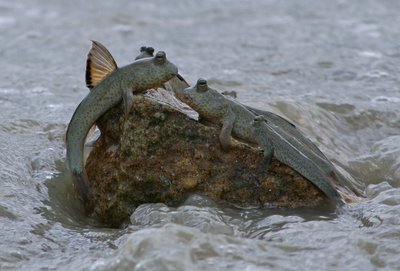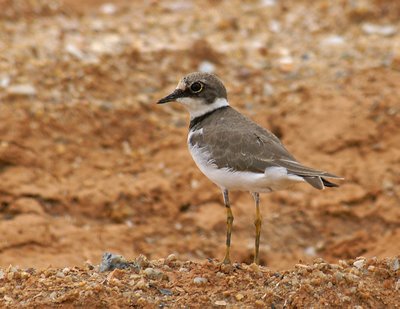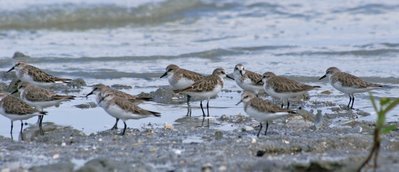Whimbrel 2
Kentish Plover 8 (including 2 males)
Little Ringed Plover 5
Lesser Sand Plover 15
Greater Sand Plover 8
Pacific Golden Plover 150
Redshank 220
Greenshank 12
Marsh Sandpiper 2
Terek Sandpiper 2
Ruddy Tursntone 2
Red-necked Stint 120
Little Stint 1

King of the Castle! Mudskippers crowd every exposed rock during the rising tide.

A male Kentish Plover looking very smart in breeding dress.

This Lesser Sand Plover is lame in its right leg. The number of birds with missing, deformed or maimed legs is quite amazing. Apart from this bird, I saw a Little Egret with a deformed foot and a Red-necked Stint with the right tarsus and foot missing today. See also here

Some of the Little Ringed Plovers are moulting into breeding plumage.
I got some reasonable pictures today of the bird that I've identified as a Little Stint that's been overwintering at this site. Someone recently asked how I can differentiate Little from Red-necked Stint in non-breeding plumage, and the short answer is, I'm not 100% sure I can! However, I have seen Little Stints with Red-neckeds in Asia in spring and autumn, when they are easier to identify on plumage (including this bird), and I have noted the following suite of features that, together, I would say present a reasonable case for Little Stint:
1. Longer legs: both the tarsus and tibia length can be longer than Red-necked, sometimes obviously so (see here)
2. The bill looks slightly longer, and tapers more to a finer point than Red-necked. The lower edge of the lower mandible is slightly but noticeably decurved. Red-neckeds tend to have straight, straight-sided, rather thick-tipped bills. Head-on, Little's bill tip is finer than Red-necked's (see the bird on the left here). Some Red-neckeds do have bills approaching the shape and length of Little, so, as with all of these features, bill shape is best used together with other features)
3. The body shape: Little seems to have a fuller chest, a rounder belly, and more rounded 'shoulders' when feeding. Red-necked has a slender body with a rather flat, angular back shape. Check this picture for an illustration of the difference in the shape of the back and shoulders (Little on the left), and this one for the difference in chest and belly shape (Red-necked is the top picture, Little on the bottom).
4. The head shape: I haven't really worked this one out fully, but the difference is very distinctive! Red-necked seem to have a bigger head and more of a 'bull-neck'; the head is usually held hunched into the shoulders. Little seems to have a small head, which often sits on top of the body, rather than hunched in. The head itself is rather square on Red-necked, which a sharp angle between the rear crown and nape, while on Little, the back of the head slopes away to the nape. You might get an idea of the difference by looking at this picture again.
5. Feeding action. I don't kow how useful this is in general, but the Little Stint that has overwintered here is nearly always the most active of the stints. When a flock is feeding, it will work its way quickly from the back to the front and then leave the others behind.
6. Plumage features: I've noticed that this bird has a rather distinctive supercilium shape - tailing away and drooping slightly to a point behind the eye (see here).
The breastband is always extensive (it's a variable feature on Red-necked, with some approaching the extent on Little) and the overall upperpart colour is brownish-grey, with individual scapulars showing darker, more diffuse centres than on most Red-neckeds. However, I think there is a complete overlap in all of these plumage features on some Red-neckeds.
Anyway, here are some pictures of the Little among Red-necked that I took today.

Note the head shape (and the way it sits 'on top' of the body rather than hunched in), chesty appearance, legs and bill of the Little Stint (facing left to right - it's handy when they do that!).

This time the bird is second from the left. The difference in leg length isn't always obvious.

Not the sharpest of shots, but this one, when the bird (second from the left again)has its belly feathers tight to the body, shows the leg length well, as well as the fine-tipped bill.

An admiring crowd of mudskippers taking in the finer points of stint identifcation at close range. The Little Stint is on the right.

By now we should be getting the hang of this - spot the odd one out in the crowd - hint - it's the one facing the other direction!

By way of a contrast, here's a nice flock of long, slender-bodied, big-headed, no-necked Red-necks! No Little Stint here!

In case you think this is getting too easy, take a look at the bird third from the right in this picture (partially obscured). It's certainly a different bird. Is it another Little Stint or just a funny Red-necked?
Hmmm - looks like I might need to go back and take another look!
Comments welcome!
1 comment:
Very nice presentation. The bill pattern differences is what I could say to be able to distinguish only... The legs' height look longer in some pictures and the same in others.
Not that it is very likely to see any Red-necked in Greece....
Post a Comment